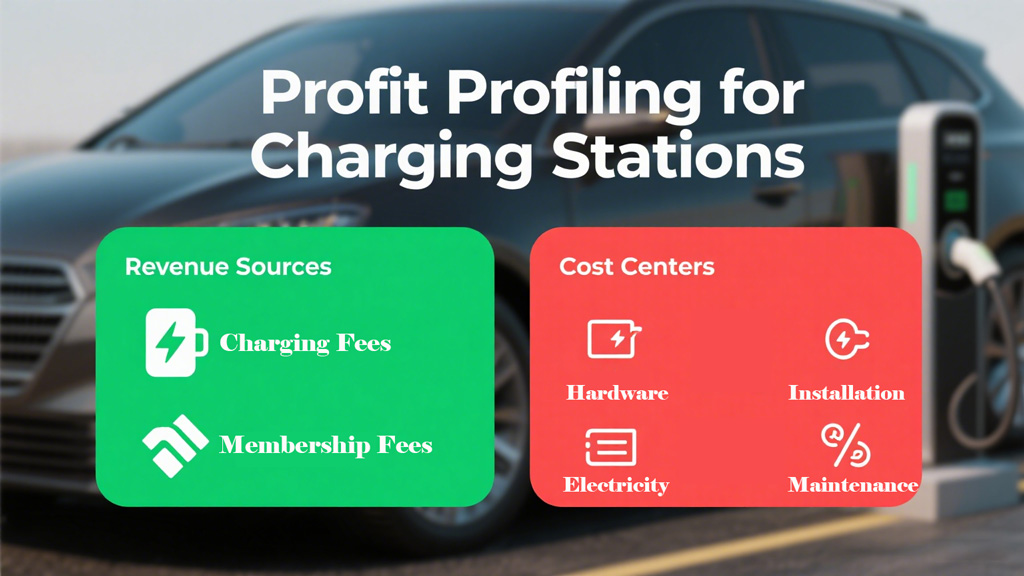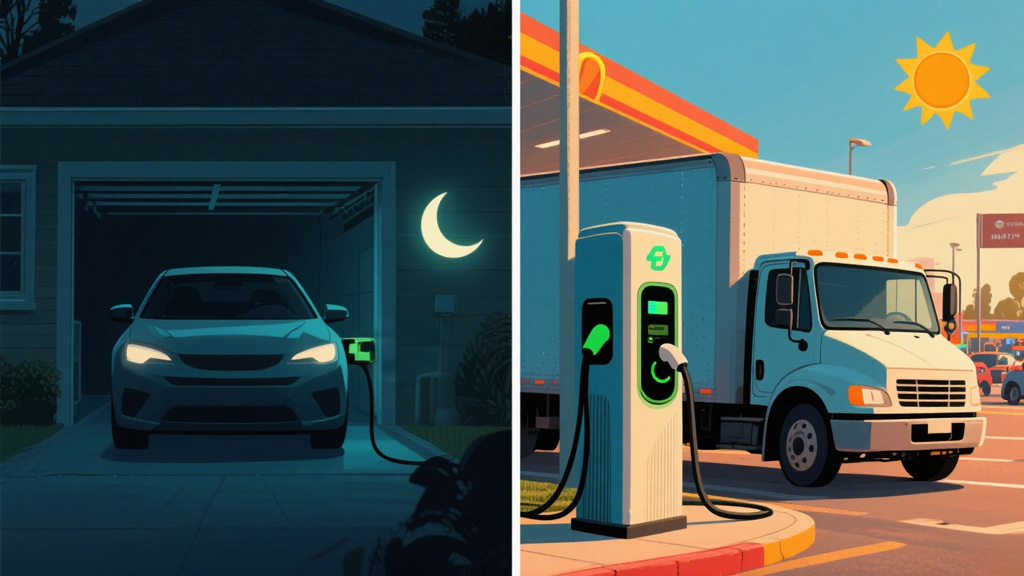So, you’re thinking about whether you should buy a charging station to make money. It’s the million-dollar question—or at least, the $50,000 question, depending on the equipment. Can you actually turn a profit by investing in electric vehicle charging?
The simple answer is yes. The more honest answer is: it depends.
But “it depends” is not a business plan. You’re wrestling with high equipment costs, confusing electricity rates, and the uncertainty of how many cars will actually show up.
Forget the vague answers. Profitability isn’t a matter of luck; it’s a matter of strategy.
This guide will move beyond the simple question of is EV charging station business profitable. We will provide you with a real-world financial framework, actionable strategies, and an exclusive, downloadable profitability calculator to build a data-driven business case.
The first step is to stop thinking of profitability as a single number. It’s a dynamic equation influenced by multiple variables.
But to truly understand the potential, you need to use the “Three-Tier Revenue Model,” which considers every way a charging station adds value to your bottom line.
Tier 2: Indirect Revenue: The value the station brings to your primary business (if you have one). This is often the most underrated and profitable aspect.
Tier 3: Future Revenue: Potential income from emerging technologies like carbon credits or selling power back to the grid (V2G).
Most analyses stop at Tier 1. We’ll show you how to leverage all three.

Before you invest a single dollar, you need to map out your potential income and expenses. This is how you determine your potential EV charging station profit margin.
How do EV charging stations make money? You have several options for pricing, each with its pros and cons.
Per-kWh (Kilowatt-hour) Fees: The most common and fair method. Drivers pay for the exact amount of energy they consume.
Per-Hour or Per-Minute Fees: Simple to implement. This is common for Level 2 charging where people park for longer periods.
Flat Session Fees: A single price per charging session. Predictable for drivers but can be unfair for those who only need a small top-up.
Subscription/Membership Fees: Offer lower rates to loyal, repeat customers who pay a monthly or annual fee. This creates a stable, recurring revenue stream.
Idle Fees: A crucial tool. These are per-minute fees that kick in after a vehicle is fully charged but remains plugged in, encouraging drivers to move and freeing up the spot for the next customer.
Advertising & Partnerships: Sell ad space on the charger’s screen or partner with a nearby coffee shop to offer a discount to charging customers.
Costs can be broken down into two categories: one-time capital expenses and recurring operational expenses.
Hardware Costs: The price of the physical electric vehicle equipment. According to the U.S. Department of Energy, Level 2 chargers can range from $3,000 to $7,000, while DC fast chargers (DCFC) can be $40,000 to $100,000+.
Installation Costs: This is a major variable. It includes labor, trenching, permits, and potentially costly electrical upgrades to your site. This can sometimes cost as much as the hardware itself.
Software Setup Fees: The initial cost to get your station connected to a management network.
Enter your estimates to project financial returns.
Network, maintenance, etc.

You can have the best equipment in the world, but if it’s in the wrong spot, it won’t make money. Use our P.L.A.C.E. framework to evaluate potential sites like a pro.
P – Population & EV Penetration: Is the site in an area with a high concentration of EV owners? Check local vehicle registration data. A wealthy, tech-savvy demographic is a strong indicator.
L – Loitering Time (Dwell Time): How long do people naturally stay at this location?
High Dwell Time (Ideal for Level 2): Workplaces, apartment buildings, hotels, movie theaters, sit-down restaurants.
Low Dwell Time (Ideal for DC Fast Chargers): Convenience stores, fast-food restaurants, major highway corridors.
A – Accessibility & Visibility: Can drivers see the station from the road? Is it easy to get in and out? A poorly designed site with difficult access will deter users. This is a critical element of EV charging station design.
C – Competition: What other public chargers are nearby? Use an app like PlugShare to scout the competition. If a nearby site is always full, that’s a great sign of unmet demand.
E – Electrical Capacity: Does the site have sufficient electrical infrastructure? Contact the local utility company early. A site that requires a new transformer could add $50,000+ to your installation cost, killing your profitability before you even start.

| Feature | Level 2 AC Charger | DC Fast Charger (DCFC) |
|---|---|---|
| Ideal Location | Workplace, Residential, Hotel | Highway, Retail, Fleet Depot |
| Target Dwell Time | 2 – 8 hours | 15 – 45 minutes |
| Upfront Cost | Low ($6k – $20k installed) | Very High ($50k – $150k+ installed) |
| Electricity Costs | Low (minimal demand charges) | Very High (significant demand charges) |
| Revenue Per Session | Lower ($5 – $15) | Higher ($15 – $30+) |
| Customer Turnover | Low | High |
| Primary Profit Model | Indirect Revenue (Attracting tenants/shoppers) | Direct Revenue (Selling energy as a primary business) |
| Payback Period | Longer (but lower risk) | Potentially shorter (but much higher risk) |
For many businesses, especially retailers and hospitality, the real money isn’t in the charging fees. It’s in the customers the chargers attract. These are some of the most overlooked benefits of ev charging stations.
Increased Foot Traffic: EV drivers plan their trips around charging. A 2022 study found that 65% of EV drivers are more likely to shop at a store that offers charging.
Longer Dwell Time = Higher Spend: While their car charges for 30-60 minutes, drivers will shop, eat, or use your services. If a non-EV driver spends $20 in 15 minutes, an EV driver who stays for 45 minutes might spend $50.
Enhanced Customer Loyalty: Offering charging is a powerful amenity that builds loyalty and leads to repeat visits.
Competitive Differentiation: In a crowded market, being the only business on the block with a charger makes you the default choice for a growing, affluent customer base.
Never leave free money on the table. Federal, state, and local utility incentives can drastically reduce your upfront costs and shorten your payback period.
The federal Renewable Fuel Infrastructure Property Credit, for example, can cover up to 30% of the cost, or $100,000.
How to Find Incentives:
Start with the AFDC: The U.S. Department of Energy’s Alternative Fuels Data Center has a comprehensive, searchable database of all state and federal laws and incentives.
Check with Your Local Utility: Many utility companies offer their own rebates for installing smart chargers that help them manage the grid.
Consult a Professional: A reputable charging station installer will be an expert on the incentives available in your specific area.
These incentives are a core part of the many business opportunities in ev and can fundamentally change your financial projections for the better.
So, are EV charging stations profitable?
The answer is an emphatic yes—if you do your homework.
Profitability is not a passive outcome. It is the result of a deliberate strategy that involves:
Choosing the right location using a data-driven framework like P.L.A.C.E.
Selecting the right type of charger for that location’s needs.
Structuring your pricing intelligently to maximize revenue and turnover.
Aggressively pursuing every available government incentive.
And most importantly, understanding and quantifying both the direct and indirect value your station provides.
Stop guessing. Download the profitability calculator, start scouting locations with the P.L.A.C.E. framework, and build a business case rooted in data, not hope. The electric future is here, and it’s full of opportunity for those smart enough to seize it.
Authoritative Sources
U.S. Department of Energy, Alternative Fuels Data Center (AFDC). Public EV Charging. https://afdc.energy.gov/fuels/electricity_charging_public.html
International Energy Agency (IEA). (2024). Global EV Outlook 2024. https://www.iea.org/reports/global-ev-outlook-2024
National Renewable Energy Laboratory (NREL). EVI-X Modeling Suite of EV Charging Infrastructure Analysis Tools. https://www.nrel.gov/transportation/evi-x.html
Database of State Incentives for Renewables & Efficiency (DSIRE). https://programs.dsireusa.org/system/program
Prześlemy szczegółowe informacje techniczne i wycenę!